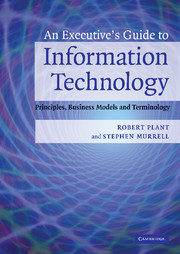Book contents
- Frontmatter
- Contents
- Introduction
- A ACM (Association for Computing Machinery) to Audio
- B Backup to Business process re-engineering
- C C, C++, C# to Cracking
- D Database to Dynamic web pages
- E e-Commerce/e-business to European Union Directive on Privacy and Electronic Commerce 2002
- F Fiber optics to Fuzzy logic
- G to H Global positioning system to Hypertext, HTML
- I ICANN (Internet Corporation for Assigned Names and Numbers) to ISP (Internet service provider)
- J to L Java to Logic programming
- M Machine learning to Multicast
- N Natural language processing (NLP) to Normalization
- O Object-oriented to Outsourcing
- P Packet switching and circuit switching to Public key-private key
- Q to R Quantum computing to RSS (Really simple syndication)
- S Sarbanes-Oxley Act of 2002 (SOX) to Structured design methodologies
- T to U T-Carrier to URL (Uniform resource locator)
- V Value added network (VAN) to Voice over IP (VoIP)
- W W3C (the World Wide Web Consortium) to WYSIWYG
- X to Z X.12 to Zip
- Index
- References
O - Object-oriented to Outsourcing
Published online by Cambridge University Press: 17 May 2010
- Frontmatter
- Contents
- Introduction
- A ACM (Association for Computing Machinery) to Audio
- B Backup to Business process re-engineering
- C C, C++, C# to Cracking
- D Database to Dynamic web pages
- E e-Commerce/e-business to European Union Directive on Privacy and Electronic Commerce 2002
- F Fiber optics to Fuzzy logic
- G to H Global positioning system to Hypertext, HTML
- I ICANN (Internet Corporation for Assigned Names and Numbers) to ISP (Internet service provider)
- J to L Java to Logic programming
- M Machine learning to Multicast
- N Natural language processing (NLP) to Normalization
- O Object-oriented to Outsourcing
- P Packet switching and circuit switching to Public key-private key
- Q to R Quantum computing to RSS (Really simple syndication)
- S Sarbanes-Oxley Act of 2002 (SOX) to Structured design methodologies
- T to U T-Carrier to URL (Uniform resource locator)
- V Value added network (VAN) to Voice over IP (VoIP)
- W W3C (the World Wide Web Consortium) to WYSIWYG
- X to Z X.12 to Zip
- Index
- References
Summary
Foundation concepts: Programming language, Algorithm.
Definition: A programming style that focuses on data objects and the operations performed on them as a whole, rather than concentrating purely on executable code and treating data as something that passively flows through it.
Overview
Object-oriented is one of the most popular bandwagons for computing professionals and organizations to jump upon. In reality it is a simple logical evolution in programming methodologies that has gradually been solidifying since the 1960s. It is certainly a Good Thing, but not necessarily the shiny bright new technology it is usually thought to be.
In the older, non-object-oriented style of programming, programmers concentrate on designing programs and algorithms that will process data. The data is viewed as a passive entity that flows through the program, and is worked on by it. Starting in a small way with Cobol in 1961, and fully taking off with the far more rational Algol-68 in 1968, programming languages provided ways of encapsulating large and complex data items, even whole databases, as single manipulable objects in a program. Programming was still viewed as producing instructions that say what to do with the data, but the data could be handled as a single well-defined object, not as an amorphous collection of binary digits.
These developments gave rise to the idea of Abstract data types (ADTs) as a tool used in the early stages of software development. With ADTs, all of the different kinds of data that a program will have to deal with are fully and formally defined, and an exact specification is provided for all of the valid operations on those data types.
- Type
- Chapter
- Information
- An Executive's Guide to Information TechnologyPrinciples, Business Models, and Terminology, pp. 233 - 249Publisher: Cambridge University PressPrint publication year: 2007



